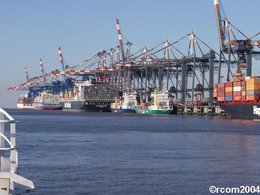Die Inhalte dieser Seite sind leider nicht auf Deutsch verfügbar.
Seitenpfad:
D2 - Suspended sediment flux in engineered estuaries
Alexander Bartholomä, Dierk Hebbeln
Mark Trevethan, Marius Becker , Li Wang, Christian Winter, Kerstin Schrottke
Mark Trevethan, Marius Becker , Li Wang, Christian Winter, Kerstin Schrottke

Estuaries are tidal influenced, funnel to tube shaped river mouths, in which complex interactions between hydro-, morpho- and sediment dynamical processes occur. A relatively high turnover of fine grained sediment is a characteristic feature. Estuaries can be seen as central interfaces between the river with its catchment area and the sea. Thus, estuaries are unique habitats as well as important economical locations.
Anthropogenic interferences in such dynamic coastal systems require detailed information of the natural process flow. Often the complex process dynamics only becomes visible through change after disturbing the systems balance. Knowledge of natural hydro-, morpho- and sediment dynamics is needed in terms of protecting these coastal systems against the impact of a potential global sea level rise or an increase of storm events.
Anthropogenic interferences in such dynamic coastal systems require detailed information of the natural process flow. Often the complex process dynamics only becomes visible through change after disturbing the systems balance. Knowledge of natural hydro-, morpho- and sediment dynamics is needed in terms of protecting these coastal systems against the impact of a potential global sea level rise or an increase of storm events.
Our research focus is based on process studies of the causal correlations between sediment source, transport dynamics and deposition (natural and anthropogenic modified) of cohesive fine grained sediments (mud).
In estuaries mud often occurs in a state, which is internationally called "fluid mud". It is a highly concentrated sediment suspension of cohesive fine grained particles, which can reduce the nautical depth considerably, depending on its density, viscosity and thickness. Echo sounders, used for the detection of water depths, are sometimes, depending on their frequency, not able to differentiate between fluid mud and the solid bottom, which can lead to problems in defining the navigability. The limit at which fluid mud can be termed navigable is still under discussion. However, convenient techniques to monitor the fluid mud are still missing as well as information on the process dynamics of these sediments.
Fluid Mud formation at slack water in the Weser estuary
Not only the presence of mud deposits but also huge bottom structures like mega ripples and subaqueous dunes, which often occur in estuaries, can endanger the navigability by reducing the nautical depth. Such mostly sandy, extremely mobile sediment structures can reduce the nautical depth by some metres. A need of continuative research work is given here as well. This task will be adopted in cooperation with other projects of RCOM.
In estuaries mud often occurs in a state, which is internationally called "fluid mud". It is a highly concentrated sediment suspension of cohesive fine grained particles, which can reduce the nautical depth considerably, depending on its density, viscosity and thickness. Echo sounders, used for the detection of water depths, are sometimes, depending on their frequency, not able to differentiate between fluid mud and the solid bottom, which can lead to problems in defining the navigability. The limit at which fluid mud can be termed navigable is still under discussion. However, convenient techniques to monitor the fluid mud are still missing as well as information on the process dynamics of these sediments.
Fluid Mud formation at slack water in the Weser estuary
Not only the presence of mud deposits but also huge bottom structures like mega ripples and subaqueous dunes, which often occur in estuaries, can endanger the navigability by reducing the nautical depth. Such mostly sandy, extremely mobile sediment structures can reduce the nautical depth by some metres. A need of continuative research work is given here as well. This task will be adopted in cooperation with other projects of RCOM.




